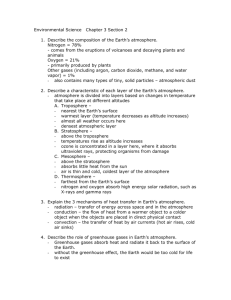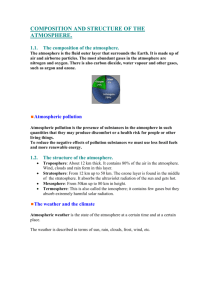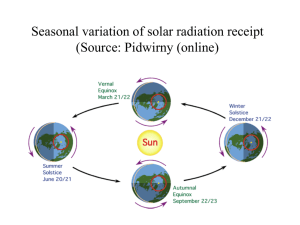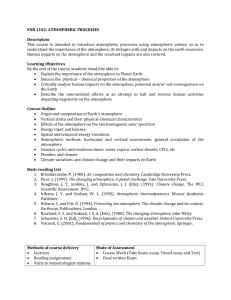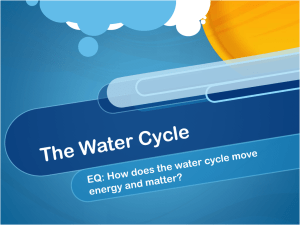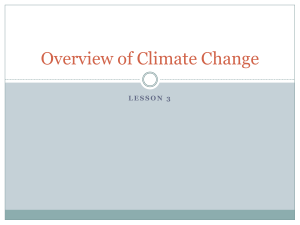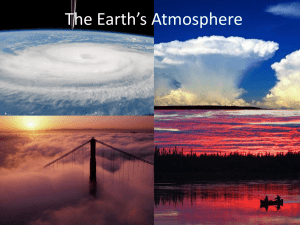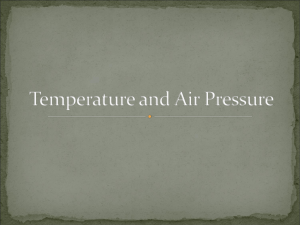INtroAtmosphere - Electrical and Computer Engineering @ UPR
advertisement
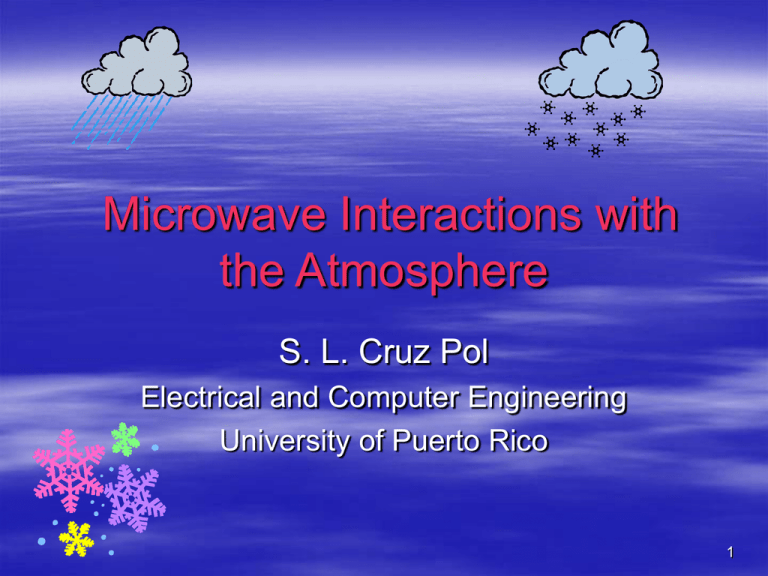
Microwave Interactions with the Atmosphere S. L. Cruz Pol Electrical and Computer Engineering University of Puerto Rico 1 Atmosphere composition Typical Atmosphere in % 21 0.93 Ni O2 Ar Other components: 78 Carbon dioxide (CO2), Neon (Ne), Helium (He), Methane (CH4), Krypton (Kr), Hydrogen (H2) and Water vapor (highly variable) 2 Atmospheric Constituents 3 Introduction Up to now, we have assumed lossless atm. For 1 GHz< f< 15 GHz ~lossless For higher frequencies, =>absorption bands H2O •22.235 GHz •183.3 GHz •IR & visible O2 •50-70GHz •118.7GHz •IR & visible 4 Outline I. The atmosphere: composition, profile II. Gases: many molecules 1. Shapes(G, VVW, L): below 100GHz, up to 300GHz e.g. H2O , O2 2. Total Atmospheric Absorption kg, opacity tq, and atm-losses Lq 3. TB: Downwelling Emission by Atmosphere Sky Temp= cosmic + galaxy 5 U.S. Standard Atmosphere Thermosphere (or Ionosphere) 1000-3000oF! Mesopause Mesosphere no aircrafts here o too cold ~-90 F Stratopause 10km Stratosphere- no H2O or dust ozone absorption of UV warms air to ~40oF Tropopause Troposphere – clouds, weather P= 1013 mbars T= 300K = 1013 HPa 6 Atmospheric Profiles US Standard Atmosphere 1962 Temperature To az T ( z ) T(11) T ( z 20) (11) 0 z 11 km 11 km z 20 km 20km z 32 km Density rair ( z) 1.225e z / H 1 or where H1 9.5km densityscale height rair ( z) 1.225e z / 7.3[1 0.3sin(z / 7.3)] Pressure P= nRT/V=rairRT/M or Poe-z/H3 where H3 7.7km Pressurescale height 7 Water Vapor Profile Depends on factors like weather, seasons, time of the day. It’s a function of air temperature. •Cold air can’t hold water •Hot air can support higher humidities.(P dependence) rv(z) roe-z/H4 [g/m3] where ro averages 7.72 in mid latitudes and the total mass of water vapor in a column of unit cross section is M r ( z ) dz r o H 4 0 where H 4 between 2 2.5km water- vaporscale height 8 9 EM interaction with Molecules Total internal energy state for a molecule – electronic energy corresponding to atomic level – vibration of atoms about their equilibrium position – rotation of atoms about center of molecule – E = Ee + Ev + Er Bohr condition fml= (Em - El ) /h Values for energy differences for – electronic: 2 to 10 eV – vibrational-rotational: 0.1 to 2 eV – pure rotational: 10-4 to 5 x 10-2 eV ( microwaves) 10 Line Shapes Absorption One molecule frequency Many molecules: pressure broaden* frequency *caused by collision between molecules k a ( f , f lm ) 4f Slm F ( f , f lm ) c where, – Slm is the line strength – F(f,flm) is the line shape LINE SHAPES – Lorentz – Gross – Van-Vleck-Weisskopt 11 Line shapes Lorentz Gross FL ( f , f lm ) FG ( f , f lm ) 1 ( f f lm ) 2 2 4 ff lm ( f lm2 f 2 ) 2 4 f 2 2 1 Van-Vleck-Weisskopt 2 1 f Fvw ( f , f lm ) f lm ( f lm f ) 2 2 ( f lm f ) 2 2 12 Absorption Bands Brightness Temperature [K] Mainly water and oxygen for microwaves Frequency [GHz] 13 Total Atmospheric Absorption kg, k g k H O kO 2 Opacity tq, 2 t q k e ( z ) secqdz 0 secq t o Loss factor Lq t o secq Lq e k g ( z ) secqdz e0 14 Atmospheric Emission For clear atmosphere TDN secq k a ( z ' )T ( z ' )e t ( 0, z ') secq dz' 0 where t (0, z ' ) k a ( z )dz 0 Also there is some background radiation Textra Tcos mic Tgallactic Tcos=2.7K from the Big Bang and Tgal~0 above 5GHz 15 Relative Humidity Air Temperature Vapor air can hold Relative humidity 27.6 Actual Vapor in the air [gr per kg dry air] 10.83 86oF 77oF 20.4 10.83 53% 68oF 14.9 10.83 72% 59oF 10.8 10.83 100% 39% 16 Aviris 17
